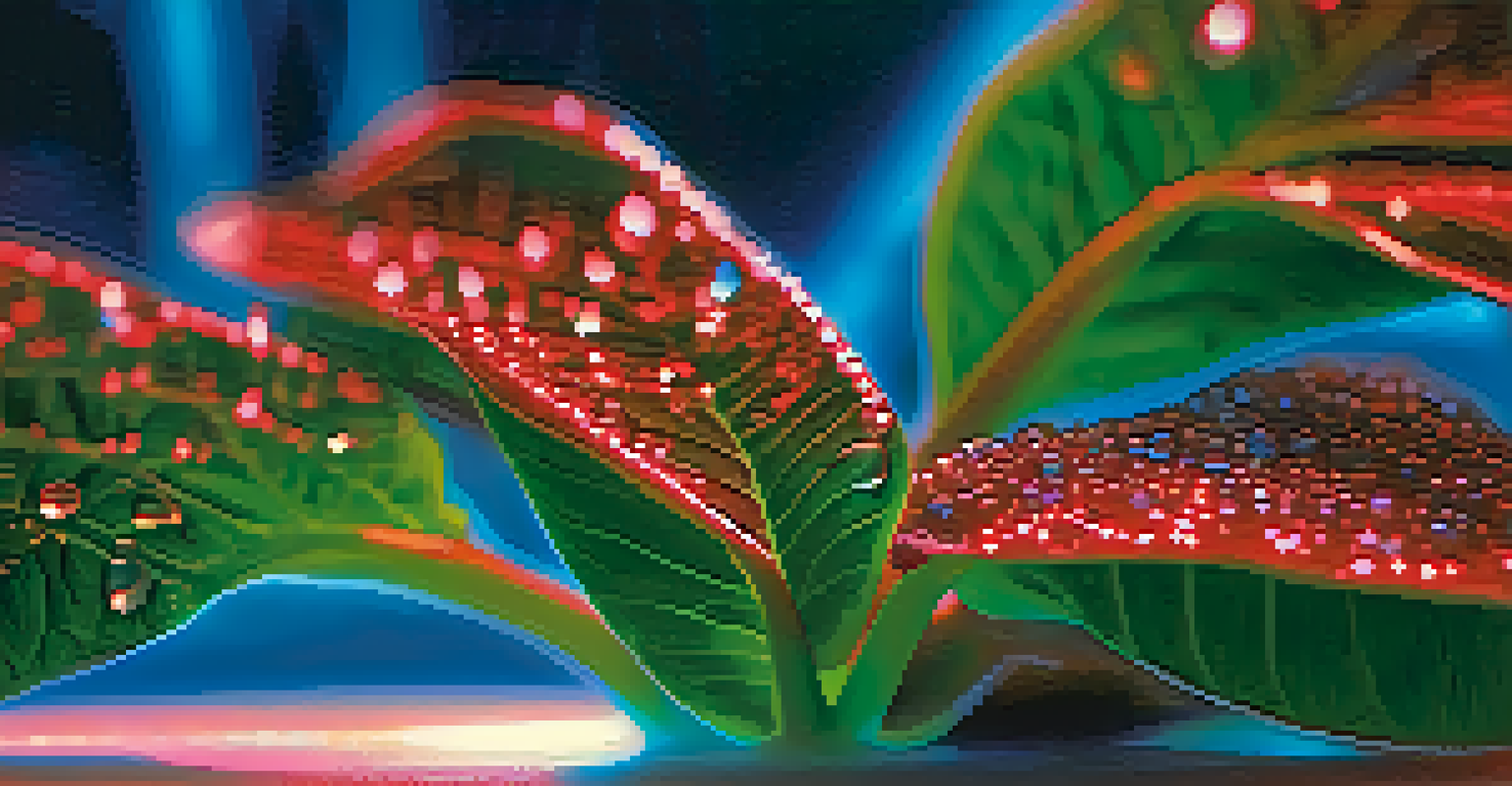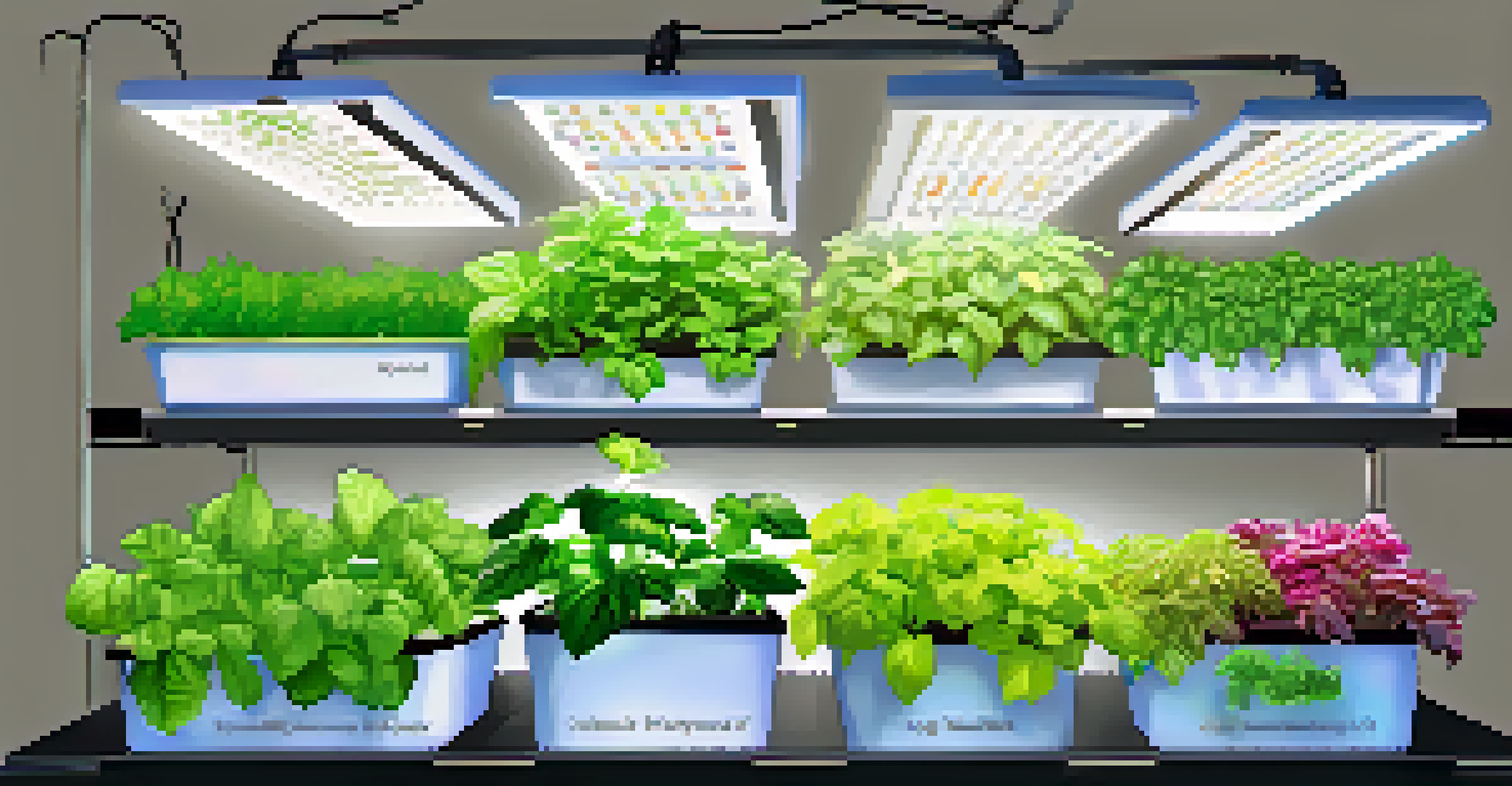The Role of Light in Hydroponic Plant Growth

The Importance of Light in Plant Growth
Light is one of the fundamental elements for plant growth. In hydroponics, where soil is absent, plants rely heavily on artificial lighting. This makes understanding light's role essential for hydroponic success.
The greatest gift of the garden is the restoration of the five senses.
Plants use light primarily for photosynthesis, a process that converts light energy into chemical energy. Without adequate light, photosynthesis slows down, leading to stunted growth and poor yields. The right light can significantly enhance the growth rate and health of hydroponic plants.
Moreover, light quality can affect plant characteristics like flavor, color, and nutritional content. By managing light effectively, hydroponic gardeners can grow healthier plants that are more flavorful and nutritious.
Types of Light for Hydroponics
In hydroponics, various types of artificial light can be used, including fluorescent, LED, and HID (High-Intensity Discharge) lights. Each type has its advantages and disadvantages, making the choice dependent on specific plant needs and growth stages.

LED lights are gaining popularity for their energy efficiency and long lifespan. They emit a spectrum of light that can be tailored to the plants' needs, which is particularly beneficial during different growth phases. This can lead to healthier plants and lower energy costs.
Light is Crucial for Plant Growth
Plants rely on light for photosynthesis, making it essential for their growth and overall health.
On the other hand, HID lights, while more powerful, consume more energy and generate more heat. They are excellent for large-scale operations but may require additional cooling systems to maintain optimal temperatures for plant growth.
Understanding Light Spectrum and Plant Needs
Plants absorb light at different wavelengths, primarily in the blue (400-500 nm) and red (600-700 nm) parts of the spectrum. Blue light promotes vegetative growth, while red light is crucial for flowering and fruiting stages.
Plants are the earth's endless effort to speak to the listening heaven.
When growing hydroponically, it's essential to balance these light wavelengths to support various growth stages. For instance, young plants thrive under more blue light, while mature plants benefit from increased red light for flowering.
By utilizing grow lights that provide a full spectrum, gardeners can simulate natural sunlight, creating a conducive environment for plants to flourish throughout their life cycle.
Duration of Light Exposure: Day Length Effects
In addition to light quality, the duration of light exposure, known as photoperiod, plays a critical role in plant growth. Different plants have varying light duration needs; some thrive with 12 hours of light, while others may require up to 18 hours.
Adjusting the photoperiod can trigger flowering or vegetative growth. For instance, many flowering plants require a shift in light duration to initiate blooming, making it crucial for hydroponic gardeners to monitor and adjust lighting schedules.
Choose the Right Light Type
Different artificial light types, like LED and HID, have unique benefits that cater to specific plant needs.
Maintaining a consistent light schedule helps regulate plant growth cycles, leading to healthier, more productive plants. This careful management can significantly influence the overall yield and quality of the harvest.
Effects of Light Intensity on Plant Growth
Light intensity, or the amount of light reaching the plants, is another critical factor in hydroponic growth. Each plant species has its own light intensity requirements, and understanding these needs can prevent issues like leaf burn or insufficient growth.
For instance, leafy greens typically thrive in lower light intensities, while fruiting plants may require higher intensity to produce a bountiful harvest. It’s like tuning an instrument; finding the right intensity can lead to harmonious plant growth.
Growers can use light meters to measure and adjust the intensity of their artificial lights, ensuring that they meet the specific needs of their plants. Proper management of light intensity can lead to optimized growth and healthier plants.
The Role of Light in Disease Prevention
Interestingly, light also plays a role in disease prevention for hydroponic plants. Adequate light helps maintain strong, healthy plants that are more resistant to pests and diseases.
Plants grown in low light conditions may become weak and leggy, making them more susceptible to fungal infections and pests. By ensuring that plants receive the right amount and quality of light, growers can promote robust health and reduce disease incidence.
Manage Light Intensity and Duration
Adjusting light intensity and exposure duration is vital for optimizing plant growth and maximizing yields.
Moreover, certain light wavelengths, particularly ultraviolet (UV) light, have been shown to deter pests and pathogens. Incorporating UV light into the growing environment can act as a natural defense mechanism, providing an additional layer of protection for hydroponic plants.
Conclusion: Maximizing Growth with Light Management
In conclusion, understanding the role of light in hydroponic plant growth is essential for achieving optimal yields. By carefully selecting the type of light, managing its intensity and spectrum, and adjusting exposure duration, growers can create an ideal environment for their plants.
Light not only supports photosynthesis but also influences plant health, flavor, and disease resistance. Each aspect of light management contributes to the overall success of a hydroponic garden.

As more people turn to hydroponics for sustainable growing, mastering light management will be a key factor in producing healthy, thriving plants. With the right knowledge and tools, anyone can become a successful hydroponic gardener.